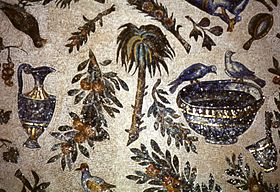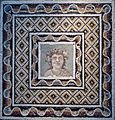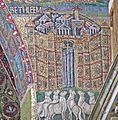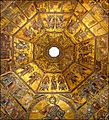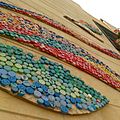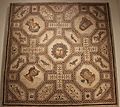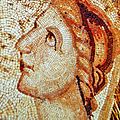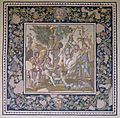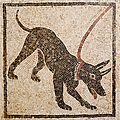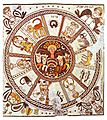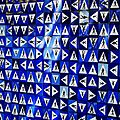Mosaic facts for kids
Mosaic is the art of decorating a surface with pictures and patterns made of little pieces of stone, glass or tiles of different colours. Mosaics can be used indoors on walls, floors and ceilings. Mosaics are sometimes used outdoors on pavements.
Making mosaics
Mosaics are made by setting coloured pieces into "mortar" (cement) which sets hard and holds the pieces in place. Some mosaics are made of round pebbles, and have only two or three colours. Other mosaics are made of marble. Many mosaics, particularly in Italy, are made of terracotta tiles. (Terracotta is "fired" clay that has been baked in an oven.) Terracotta tiles come in many colours and can be used for colourful pictures as well as patterns.
Some tiles look as if they are made of pure gold. These tiles are actually made of glass and have a very thin "leaf" of gold stuck to one side. The side with the gold gets put into the mortar. Then the gold can be seen through the glass, but cannot be scratched off.
History
Mosaics often last for a very long time. There are still plenty of mosaics which were made by the Ancient Romans. They can be seen in Italy, England, France, as well as other countries that were once part of the Roman Empire.
Many beautiful mosaics date from the early Christian and Byzantine eras, from about 300 AD to 1400, in Italy, Greece, and other countries. The mosaics in churches usually have pictures which tell Bible stories.
Mosaics were a popular way to decorate churches in Italy in the Medieval period. They were not popular in England, France, Germany and countries of Northern Europe because they preferred to use stained glass windows as decoration. In Italy, the most famous church with its interior decorated with mosaics is St. Mark's Basilica, Venice. At Westminster Cathedral in London, (which is built in an Italian style) the mosaic decoration which was started more than 100 years ago is still continuing, bit by bit. Many of the mosaics at St. Mark's and Westminster Cathedral have gold backgrounds.
Nowadays mosaics are still used in all sorts of ways. Mosaics are most often used to brighten up public places in cities. Modern mosaics are made of all sorts of materials: mosaic tiles, bathroom tiles, broken roof tiles, broken dishes, broken mirrors, bits of metal and old bricks.
Related pages
Gallery
-
This old guest house in China has a mosaic with a Chinese symbol
-
A Byzantine mosaic from Ravenna, Italy showing gold tiles
-
A mosaic from c.1900, Westminster Cathedral, London
-
A 20th century mosaic decorating a house in the Czech Republic
-
A modern mosaic made of bathroom tiles on a pavement in Wales
-
Cone mosaic courtyard from Uruk in Mesopotamia 3000 BC
-
A mosaic of the Kasta Tomb in Amphipolis depicting the abduction of Persephone by Pluto, 4th century BC
-
The Good Shepherd mosaic in the Mausoleum of Galla Placidia, Ravenna
-
Saint Peter mosaic from the Chora Church
-
Byzantine mosaic above the entrance portal of the Euphrasian Basilica in Poreč, Croatia (6th century)
-
A pre-Iconoclastic depiction of St. Demetrios at the Hagios Demetrios Basilica in Thessaloniki.
-
Mosaic of Christ Pantocrator from Hagia Sophia from the Deesis mosaic.
-
A mosaic from the Hagia Sophia of Constantinople (modern Istanbul), depicting Mary and Jesus, flanked by John II Komnenos (left) and his wife Irene of Hungary (right), c. 1118 AD
-
Saracen arches and Byzantine mosaics in the Cappella Palatina of Roger II of Sicily
-
Monreale mosaics: William II offering the Monreale Cathedral to the Virgin Mary
-
A “painting” made from tesserae in St Peter's Basilica, Vatican State, Italy
-
Jerusalem on the Madaba Map
-
Mosaic floor from the church on Mount Nebo (baptistery, 530)
-
The Transfiguration of Jesus in the Saint Catherine's Monastery
-
Detail from the mosaic floor of the Byzantine church of in Masada. The monastic community lived here in the 5th–7th centuries.
-
Early 12th-century Kievan mosaic depicting St. Demetrius.
-
Complex Mosaic patterns also known as Girih are popular forms of architectural art in many Muslim cultures. Tomb of Hafez, Shiraz, Iran
-
Islamic mosaics inside the Dome of the Rock in Palestine (c. 690)
-
The Umayyad mosaics of Hisham's Palace closely followed classical traditions
-
Golden mosaics in the dome of the Great Mosque in Corduba, Moorish Spain (965–970)
-
Mosaic art at Bonifacio High Street in Bonifacio Global City, Philippines
-
The mosaic of The Beauty of Durrës, late 4th century BC. Now in the National Historical Museum in Tirana
-
Cave canem mosaics ('Beware of the dog') were a popular motif for the thresholds of Roman villas
-
A small part of The Great Pavement, a Roman mosaic laid in AD 325 at Woodchester, Gloucestershire, England
-
The Zliten mosaic showing gladiators, 2nd century AD
-
Roman mosaic found at Calleva Atrebatum (Silchester)
-
Late Roman mosaics at Villa Romana La Olmeda, Spain, 4th-5th centuries AD
-
Judgment of Paris, marble, limestone and glass tesserae, 115–150 AD; from the Atrium House triclinium in Antioch-on-the-Orontes
Images for kids
-
From Pompeii, Casa di Orfeo National Archaeological Museum, Naples
-
Detail of a Paleochristian mosaic from the basilica of Santa Pudenziana in Rome, c. 410 AD, depicting Saint Pudentiana
-
Mosaic of Justinian I in Basilica of San Vitale, Ravenna
-
Another example of a Zodiac wheel on the floor of the synagogue, this time in Beit Alfa.
-
Mosaic of Menorah from Hammam Lif synagogue, Tunisia, 6th c. Brooklyn Museum
-
Art mosaic, University of Bremen, Germany.
-
A Hellenistic Greek mosaic depicting the god Dionysos as a winged daimon riding on a tiger, from the House of Dionysos at Delos in the South Aegean region of Greece, late 2nd century BC
-
This centaur mosaic was found on the site of the Roman emperor Hadrian's Villa near Tivoli, Italy. Altes Museum, Berlin.
See also
 In Spanish: Mosaico para niños
In Spanish: Mosaico para niños



